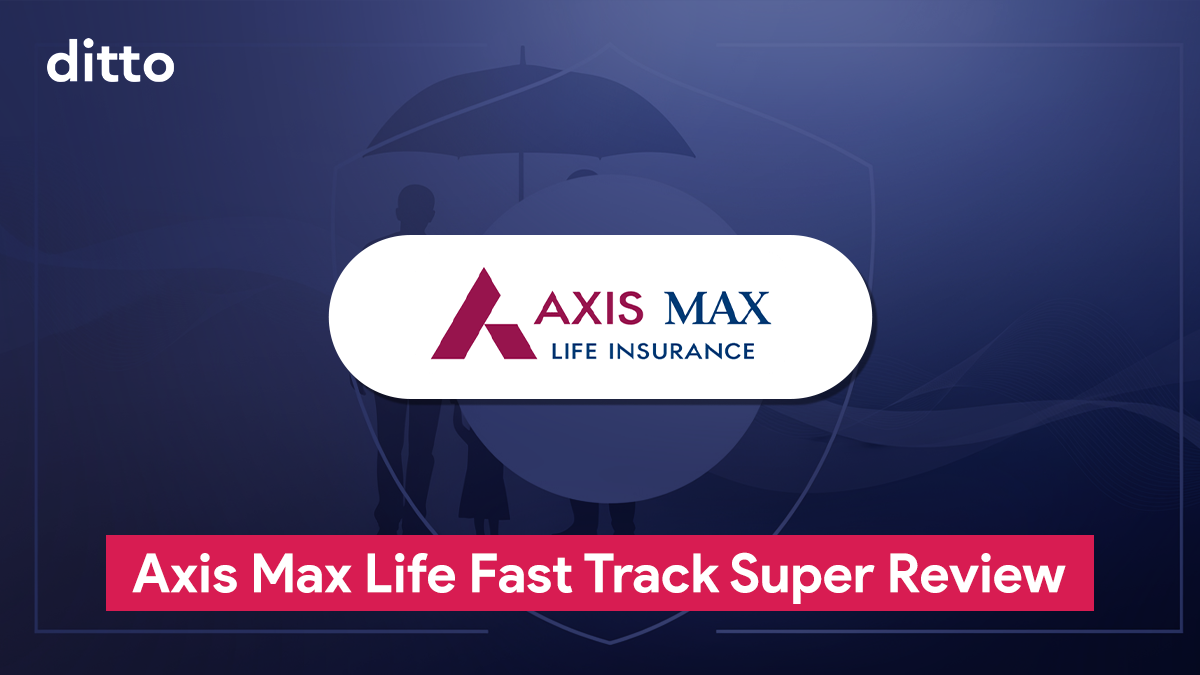Axis Max Life Fast Track Super is marketed as a ULIP that gives you “investment flexibility with financial protection.” The brochure highlights its wide range of 16 fund options, automated investment strategies to cushion volatility, and multiple premium payment choices to suit different investor profiles. It also emphasizes the idea of long-term wealth creation while keeping your family financially secure through life cover.
But as with most ULIPs, the glossy brochure leaves out the fine print. Features like “flexibility,” “market-linked growth,” and even “life cover” sound impressive until you unpack the numbers and the layered charges. The real test of a ULIP isn’t in its promises, but in whether the structure adds enough value after costs, restrictions, and lock-ins. That’s exactly what we’ll explore in this review.
Still confused? Speak to a Ditto advisor before you lock yourself into a 10–20 year ULIP. They’ll help you decide if a ULIP even makes sense for your financial goals, or if you’re better off separating investments from insurance
Quick Overview: What Is Axis Max Life Fast Track Super?
Axis Max Life Fast Track Super is a Unit Linked Insurance Plan (ULIP) designed to pair long-term market-linked growth with basic life protection. Policyholders can choose between three premium payment styles—Single Pay, 5 Pay (10-year term), or Regular Pay (20-year term)—and allocate funds across 16 investment options that range from low-risk debt to aggressive equity and index funds.
Some headline features include:
1) Multiple Payment and Term Options:
Single Pay, 5 Pay (10 years), or Regular Pay (20 years).
2) Market-Linked Growth with Life Cover:
Maturity benefit is your fund value, while the death benefit is the higher of (Sum Assured, Fund Value, or 105% of premiums paid).
3) 16 Fund Choices Across Risk Profiles:
A broad menu of funds spanning equity, debt, balanced, and even factor/index-based strategies.
4) Strategies to Cushion Market Volatility:
You can opt for automated approaches like the Systematic Transfer Plan (STP), which drip-feeds money into equity funds, or Dynamic Fund Allocation (DFA), which reduces equity exposure as maturity nears.
5) Partial Withdrawals After Lock-In:
From the 6th year, the policy allows limited withdrawals, adding some liquidity.
What Premium Payment and Policy Term Options Does Axis Max Life Fast Track Super Offer?
Axis Max Life Fast Track Super tries to position flexibility as a benefit so you can choose how you want to pay and how long to stay invested:
- Single Pay: One-time lump sum for a 10-year term
- 5 Pay: Premiums for 5 years, with a 10-year policy term
- Regular Pay: Premiums for 20 years, with a 20-year policy term
But this structure is not unique and has limitations. ULIPs are long-term products, and compounding needs time. The 10-year options (Single Pay and 5 Pay) may not give enough runway for equity-heavy funds to deliver meaningful growth. This is especially true once you factor in allocation charges, fund management charges, and mortality costs.
The 20-year Regular Pay plan is the only variant that genuinely aligns with ULIP logic: a long investment horizon that allows market cycles to smooth out. And conveniently, that’s also the only variant where you get Loyalty Additions (extra units added from year 11 onward).
Ditto’s Verdict: While Axis Max Life markets “multiple payment options” as flexibility, it’s more of a design choice than a feature. If you’re considering this plan at all, the shorter options don’t really make sense for wealth creation.
How Does Axis Max Life Fast Track Super Combine Market-Linked Growth with Life Cover?
Axis Max Life Fast Track Super promises the “best of both worlds” — market-driven growth and a safety net for your family. But let’s break down what this really means.
The maturity benefit is straightforward: you get your fund value at the end of the policy term. No guaranteed additions, no maturity bonus (except for the Regular Pay option) — just whatever your investments have grown to after deducting charges.
The death benefit is defined as the higher of:
- Fund Value
- Sum Assured (which depends on your premium, payment term, and entry age)
- 105% of total premiums paid
But this isn’t a special feature; it’s simply compliance because IRDAI mandates all ULIPs to offer a life cover that is at least 10x of the annual premium.
Let’s take an example: If you pay ₹1 lakh annually under a 20-year Regular Pay plan, your life cover will typically be ₹10 lakhs. If you pass away in year 8 and your fund value hasn’t grown much, your nominee may just receive this ₹10 lakh — which is not very different from what you’ve already paid in premiums.
Reality check: The “life cover” component in Axis Max Life Fast Track Super is minimal compared to standalone term insurance. In contrast, a pure term plan for the same ₹1 lakh annual outgo could easily fetch you ₹1 crore or more in coverage and leave you with an investible surplus.
Ditto’s Verdict: Axis Max Life Fast Track Super’s combination of growth and protection looks good in marketing copy, but the insurance element is underwhelming. If life cover is your primary goal, a separate term plan is far superior. This ULIP only makes sense if your main aim is market-linked investment, and you’re comfortable with its costs and restrictions.
What Fund Options Can You Choose in Axis Max Life Fast Track Super?
With the Fast Track Super, you get access to 16 different funds across equity, debt, balanced, and even factor/index-based strategies like Nifty Alpha 50 and Momentum. It also allows 12 free fund switches per year (with 6 free premium redirections), but realistically, you shouldn’t be switching that often anyway.
To tell you the truth, most investors will gravitate toward just a few of these funds based on their risk appetite. Aggressive investors may lean into the equity-heavy funds like High Growth or Nifty Alpha 50, while conservative investors will stick to debt-oriented funds like Secure or Debt Fund. The rest exist to make the menu look extensive, but won’t be relevant to most buyers.
Ditto’s Advice: Don’t be swayed by the promise of “16 fund options.” If your primary goal is wealth creation, direct mutual funds give you the same market exposure with lower costs and far greater transparency. ULIPs like Axis Fast Track Super bundle investment with insurance, but that structure is inherently less efficient.
How Does Axis Max Life Fast Track Super Help Manage Market Volatility?
Axis Fast Track Super highlights two strategies that claim to protect your money from market ups and downs:
1) Systematic Transfer Plan (STP):
Your premium initially goes into a low-risk debt fund and is gradually shifted into equity funds each month. This mimics rupee cost averaging — buying equity units in instalments instead of all at once.
2) Dynamic Fund Allocation (DFA):
Here, the policy automatically reduces equity exposure and moves money into debt funds as your policy nears maturity. The idea is to lock in gains and lower volatility over time.
Ditto’s Verdict: Axis Max Life Fast Track Super’s volatility management strategies are more about convenience than actual protection. They’re useful if you prefer a “set it and forget it” approach, but they don’t give you an edge over disciplined investing in mutual funds.
Can You Make Partial Withdrawals from Axis Max Life Fast Track Super?
Yes, but only after the mandatory lock-in. Like all ULIPs, Axis Fast Track Super comes with a 5-year lock-in period. That means you cannot touch your money in the early years, even in emergencies.
Once you cross the 5-year mark, the plan allows partial withdrawals from the 6th year onwards, subject to certain conditions. Typically, you can withdraw a minimum amount (say ₹5,000) and only if your fund value remains above a prescribed level after withdrawal. The policy brochure also makes it clear that frequent or high withdrawals could reduce your future benefits and may even affect the life cover linked to your plan.
Ditto’s Verdict: The partial withdrawal option in Axis Max Life Fast Track Super is a standard ULIP feature — not a unique benefit. It may help in emergencies after year 5, but if flexibility is a priority, you’re better off with mutual funds or a combination of term insurance + liquid investments.
What Are the Charges in Axis Max Life Fast Track Super?
Like all ULIPs, Axis Max Life Fast Track Super comes with multiple layers of charges that eat into your returns. Here’s the breakdown:
| Charge Type | Details |
|---|---|
| Premium Allocation Charge (PAC) | - Regular Pay: 2.5% (Year 1), 2% (Year 2 onward) - 5 Pay & Single Pay: 3% (Year 1), 2% (later) |
| Policy Administration Charge | - ₹40/month for first 5 years - Increases 5% annually from Year 6 (capped at ₹500/month) |
| Fund Management Charge (FMC) | - Equity/Hybrid: up to 1.25% p.a. - Debt: ~1% p.a. - Liquid: ~0.90% p.a. |
| Mortality Charge | - Based on age & sum at risk - ~₹1.3 per ₹1,000 sum assured for a healthy 30-year-old; rises with age |
| Other Charges | – 12 free fund switches/year; ₹250 thereafter – Partial withdrawals free (within limits) – High discontinuance charges before 5 years |
Ditto’s Verdict: Axis Max Life Fast Track Super’s charges are not unusual for a ULIP, but they are heavier than what top peers levy. The biggest drag comes from premium allocation and policy administration charges. Competitors like HDFC Click 2 Wealth (zero alloc/admin + refund of mortality charges) and ICICI Pru Signature (refund of policy admin charges) clearly outshine Fast Track Super. Over a 20-year horizon, these deductions can quietly erode lakhs from your final corpus. And when you compare with mutual funds, the gap only widens since MFs charge only a transparent expense ratio with no layered deductions.
Axis Max Life Fast Track Super vs Other Popular ULIPs
When you put Axis Max Life Fast Track Super side by side with other market-leading ULIPs, its position becomes clearer.
1) Loyalty Additions:
The Fast Track Super only begins adding loyalty units from year 11 under the Regular Pay option. In contrast, ICICI Pru LifeTime Classic and SBI Life Smart Builder start rewarding persistence as early as year 6. This makes competitors more attractive for investors who don’t want to wait over a decade for loyalty benefits.
2) Life Cover Efficiency:
Like all ULIPs, Fast Track Super offers the minimum 10× annual premium life cover. But ULIPs such as HDFC Life Click 2 Wealth and Bajaj Allianz Goal Assure II go a step further by refunding mortality charges at maturity (ROMC). This effectively reduces the cost drag, giving them an edge over Fast Track Super in long-term returns.
3) Fund Choices and Switching:
The Fast Track Super highlights its 16 fund options, but that’s not unique. HDFC Click 2 Wealth and Bajaj Allianz Goal Assure II also offer a wide menu with unlimited free fund switches, while Axis caps free switches at 12 per year. On top of that, ICICI Pru Signature refunds policy administration charges every 5 years, offsetting costs in a way the Fast Track Super doesn’t.
4) Volatility Management:
The Fast Track Super provides STP and DFA as preset strategies. But ICICI Pru LifeTime Classic and ABSLI Liquid Wealth Plus also offer similar automated rebalancing features — often paired with earlier loyalty additions or lower effective charges.
Ditto’s Take: Axis Max Life Fast Track Super is competitive but doesn’t really outshine peers. It lags behind on loyalty additions, charge refunds, and value-added features like ROMC. If you want a ULIP, insurers like ICICI Pru, HDFC Life, Bajaj Allianz Life, or SBI Life provide stronger benefits for long-term investors.
Final Thoughts
Axis Max Life Fast Track Super isn’t a bad ULIP, but it’s not a standout either. The fund menu is broad, the volatility strategies are convenient, and the life cover ticks regulatory boxes. Yet, once you add up the layered charges and the late start of loyalty additions, the overall value falls short compared to alternatives like HDFC Life Click 2 Wealth, ICICI Pru Signature, or Bajaj Allianz Goal Assure II.
So If your goal is pure wealth creation, mutual funds paired with a term plan will give you higher returns and stronger protection. If you still want a ULIP, compare across insurers some offer earlier loyalty additions or refund key charges that the Axis Max Life Fast Track Super doesn’t.
Still confused? Speak to a Ditto advisor before you lock yourself into a 10–20 year ULIP. They’ll help you decide if a ULIP even makes sense for your financial goals, or if you’re better off separating investments from insurance.
Last updated on:








